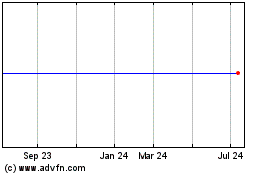Whole Foods Is Stung by Rivals -- WSJ
July 28 2016 - 3:03AM
Dow Jones News
By Heather Haddon
Whole Foods Market Inc. offered a pessimistic outlook for the
coming months as it reported another quarter of weak sales amid
stiff competition and declining food prices.
Its comparable stores sales, a key metric for retailers, fell by
2.6% in the fiscal third quarter ending July 3, the company
reported Wednesday. The decline was roughly in line with analysts'
predictions of a 2.3% drop.
"It remains a very, very competitive market out there," Walter
Robb, co-chief executive, told investors.
The grocer has slashed prices, offered discounts, and launched a
pilot loyalty program that is one of the hallmarks of traditional
grocers. But greater competition from supermarket chains such as
Kroger Co. is continuing to undercut the Austin, Texas-based food
grocer's dominance in natural foods and it has offered lower prices
to try to compete.
Whole Foods can't depend on customers traveling to shop there
given the prevalence of the goods at other stores, said John
Mackey, co-chief executive for Whole Foods.
"People may not be driving as frequently or as a far as they
used to because they can stop by a Krogers or a HEB or a Wegmans,"
Mr. Mackey said.
The high-end grocer, whose name became synonymous with natural
and organic foods, has been beset by a sales slowdown. In addition,
it has faced some bad publicity, including a recent warning from
U.S. health regulators over food safety at a Massachusetts plant
that makes prepared foods and other products. Mr. Mackey said the
problems flagged by inspectors have been resolved or would be
soon.
Analysts cautioned that a turnaround in Whole Foods' sales will
take time. So far this quarter, comparable-store sales were down
2.4%, the company said.
Shares were down 5% at $31.95 in after-hours trading Wednesday,
and are flat year to date.
The company announced last year that it would eliminate jobs to
help offset its price discounts and it reduced more than 2,000
positions, or around 2% of its workforce, as of last September,
according to financial filings.
And it is trying to broaden its market by opening a new chain of
smaller, cheaper stores. Company executives said the first of its
new 365 by Whole Foods Market stores was attracting new shoppers
who were buying more items per transaction.
Company executives said they hadn't seen cannibalized sales from
Whole Foods' pricier full-format stores so far, but will be
monitoring its third location opening near Seattle later this year.
That store is closer to a traditional Whole Foods store.
The traditional store's comparable-store sales were up 2.5% in
the fiscal year ending last September. Its same-store sales growth
peaked at 8.8% in 2012, and have fallen since, according to company
filings.
Over all for the quarter, revenue rose 2% to a record $3.7
billion. But Whole Foods reported a profit of $120 million, or 37
cents a share, compared with $154 million, or 43 cents a share, a
year earlier. Analysts surveyed by Thomson Reuters had projected 37
cents a share on $3.73 billion in revenue.
The decline in food prices is hurting businesses across the
grocery sector even as it benefits consumers.
"Deflation, particularly in proteins, has lasted longer than
people expected," said Mark Gross, chief executive of Supervalu, a
Minneapolis-based grocery chain that also reported its earnings
Wednesday.
Supervalu's deep-discount grocery subsidiary, Save-A-Lot, saw
price deflation of around 5% during its fiscal year quarter because
of falling prices of eggs, beef and milk.
Maria Armental contributed to this article.
Write to Heather Haddon at heather.haddon@wsj.com
(END) Dow Jones Newswires
July 28, 2016 02:48 ET (06:48 GMT)
Copyright (c) 2016 Dow Jones & Company, Inc.
Whole Foods Market, Inc. (NASDAQ:WFM)
Historical Stock Chart
From Mar 2024 to Apr 2024

Whole Foods Market, Inc. (NASDAQ:WFM)
Historical Stock Chart
From Apr 2023 to Apr 2024
